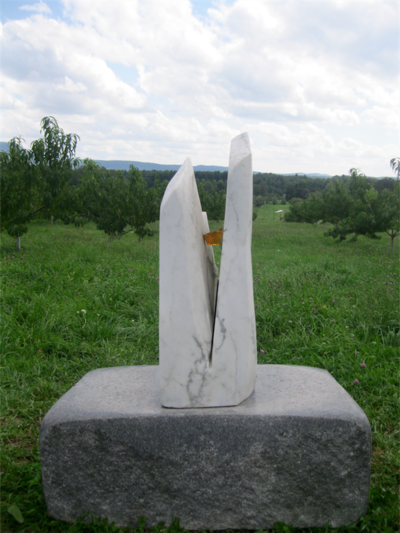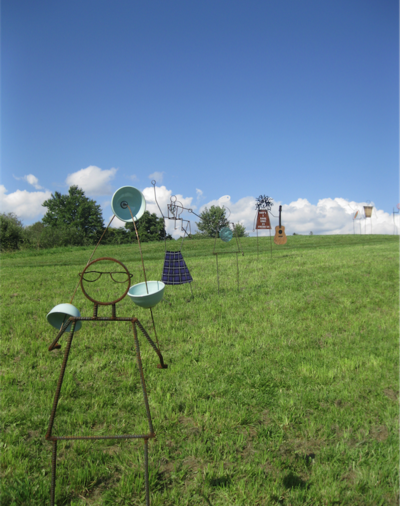Finding Culture in Agriculture: Art in the Orchard

Harold Grinspoon, Wild Wood, single live oak branch, quartered, sanded, epoxied and varnished. All photos by the author.
By Olivia J. Kiers
A biennial sculpture exhibition in an apple orchard may seem like a serendipitous venture, but for Park Hill Orchard owners Alane Hartley and Russell Braen it involved years of careful planning. Hartley expressed that she and Braen “always wanted to put the ‘culture’ in ‘agriculture.’” They had purchased the historic, 127-acre fruit farm in Easthampton, MA after carefully scouting properties across many states, hoping that the wealth of local artists would help enact their vision for uniting farming and art. Indeed, Easthampton has been a supportive home for Hartley and Braen. With the energetic aid of local picture-framer and artist Jean-Pierre Pasche, Art in the Orchard (AiO) was born in 2011 and has grown rapidly ever since.
“I’ve watched Easthampton’s cultural renaissance evolve since the ‘90s,” says local artist and three-time AiO participant Eileen Jager. “Art in the Orchard is a part of our area’s becoming a mecca for artists. It’s a whole new kind of venue.” Now in its fourth iteration, AiO ‘17 is explored via a mile-long trail that loops through gently sloping fields. Artwork is scattered near apple trees, beehives, woods, a pumpkin patch and a floral labyrinth. Experiencing the sculptures involves experiencing the farm—best done with a fresh-made apple cider donut in hand. A family-friendly outing, AiO is nonetheless host to provocative art this year that challenges perspectives and plays with notions of the seen versus the unseen. Several sculptures reference current events and politics.

Eileen Jager, Through The Looking Glass, glass mosaic/mirror and paint on wood.
There is stylistic variety among the 30 new works on display, from the elegant contortions of Harold Grinspoon’s Wild Wood, to Beckie Kravetz’s Reunion, a quirky grouping of clay heads sprouting like mushrooms from the earth. The most successful pieces are in formal dialogue with the site. Antoinette Prien Schultze’s Arete is, on its own, a beautiful abstraction. According to the artist’s statement, this shard of amber glass wedged deep in a marble crevice “is the personification of courage.” Through positioning, it also channels the orchard’s geometry. Eileen Jager’s Through the Looking Glass has a similar dual nature. It is part of Jager’s greater vision of creating art with a healing power. The rainbow colors painted on the backs of its seven suspended frames are the colors of the chakras, for example. Yet it also plays with the landscape, simultaneously reflecting and obscuring land and sky.

Antoinette Prien Schultze, Arete, marble, granite and glass.
Interspersed along the trail are several notable works on permanent display by artists involved in previous exhibitions that also activate perspective the way Jager’s piece does. Pasche’s Big Red Frame—which became so popular as a local photo-op, Pasche renamed his custom framing business after it—and Maggie Nowinski’s mirror-covered Shed draw attention away from themselves as objects and back toward the landscape through simple gestures: framing and reflecting. Shed contains an additional trick. When its door is shut, the dark interior becomes a camera obscura projecting upside-down, ghostly visions of the orchard across a screen.
Back in the brightness of day, ghosts still appear. Air is made visible in Bruce Hooke’s eerie Wind Field, a formation of white nylon windsocks that dance in solemn unison with the breeze. Fletcher Smith’s ATTN SPAN is more playful, but equally mysterious. Only a patient viewer who observes this bright yellow and black surface from multiple angles will see the hidden image of koi fish.

Piper Foreso, Easthampton’s Big Beautiful Wall, florescent acrylic in steel base.
Even politically motivated works like Michael Melle’s Refugees and Piper Foreso’s Easthampton’s Big Beautiful Wall engage their human subject through tricks of absence like the silhouette, or approaching a group of people from behind, only to realize they are made of straw. Brendan Stecchini’s Transmission: Free Speech Memorial takes away the figure, and inserts sound. His formation of mouth-height, swiveling steel trumpets acts as an interactive amplifier. Participants can subvert their role from speaker to surveillant by peering rather than speaking down the tube, yet again bringing perspective into play.
For all of the challenging works on display, one of the most impactful is, like AiO itself, about community. Towards the end of the long trail, Michael Poole’s Our Tribe fills an entire hillside with welded, stick-figure portraits of locals that are immediately accessible and engaging. “I have met quite a few people who recognized friends we have in common from the sculptures, and took the time to reach out and introduce themselves,” Poole says. While he calls himself a relatively new Easthampton resident, Poole says his experience with this “community that believes ‘a rising tide lifts all boats’” has encouraged him to submit to more calls for art and truly pursue his calling.

Detail of Michael Poole, Our Tribe, mixed media.
So Alane Hartley and Russell Braen’s groundwork has borne great fruit. Their orchard is indeed a new nexus for culture and agriculture in Western Massachusetts. Fertilized by the Easthampton arts community, it has grown to incorporate works from out-of-state, and attracts many thousands of visitors each year. Art in the Orchard offers autumnal afternoons of art-viewing in the great outdoors, but its greatest gift back to Easthampton may be immaterial: a point of community pride.
